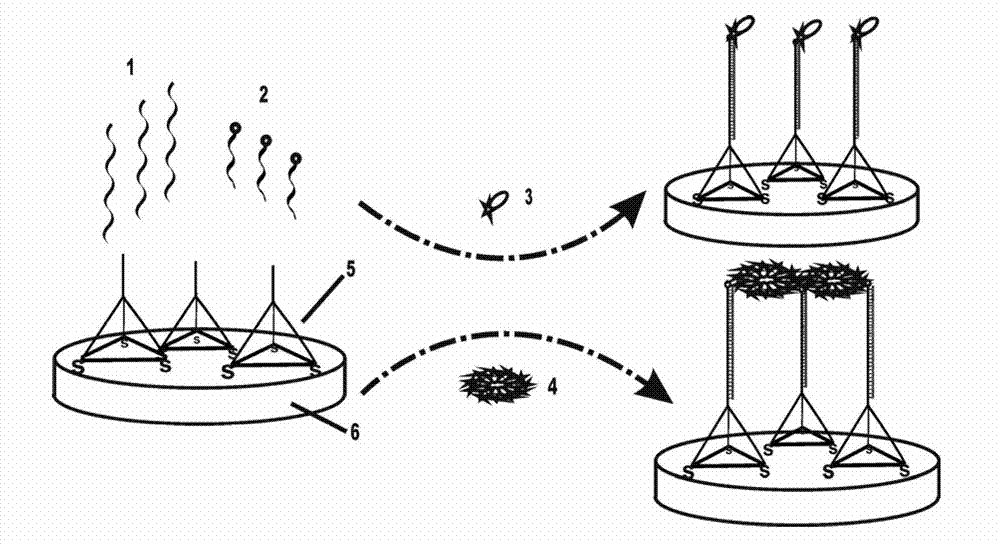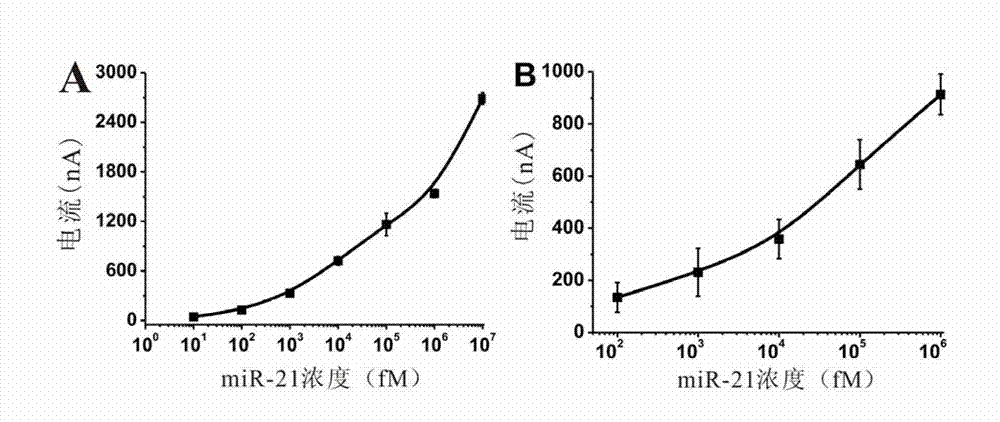Electrochemical miRNA (micro Ribose Nucleic Acid) detection method based on DNA (Deoxyribose Nucleic Acid) three-dimensional nano structure probe
A three-dimensional nanometer and detection method technology, applied in biochemical equipment and methods, microbial determination/inspection, etc., can solve problems such as a large number of target miRNAs, and achieve the effects of low cost, high stability and strong specific selectivity
- Summary
- Abstract
- Description
- Claims
- Application Information
AI Technical Summary
Problems solved by technology
Method used
Image
Examples
Embodiment 1
[0033] Reagents include:
[0034] Four single-stranded DNAs assembled to form a tetrahedral probe with a three-dimensional nanostructure of DNA, Tetra-A (75bp, molecular weight 23071.0, ssDNA), Tetra-B (55bp, molecular weight 17018.0, 5' end modified sulfhydryl ssDNA), Tetra-C (55bp, molecular weight 16898.0, ssDNA modified with thiol at the 5' end), Tetra-D (55bp, molecular weight 16877.0, ssDNA modified with thiol at the 5' end), both were purchased from Dalian Takara Biological Co., Ltd. The four single-stranded DNAs contain three structural domains, each of which is complementary to the corresponding domains of the other three single-stranded DNAs (17 pairs of bases are complementary), and each single-stranded DNA surrounds one face of the tetrahedral structure. Circle, containing two bases (non-complementary, flexible) at each vertex for bending, the 3' and 5' ends of single-stranded DNA converge at the four vertices of the tetrahedron, and Tetra-A extends at the 5' end ...
Embodiment 2
[0069] The avidin-modified horseradish peroxidase (avidin-HRP) was replaced by polyavidin-modified horseradish peroxidase (poly-HRP80), and other reagents and DNA were the same as in Example 1. Both poly-HRP80 and poly-HRP80 dilutions were purchased from Fitzgerald Industries International. poly-HRP80 is a supramolecular enzyme complex containing 400 (80*5) HRP molecules, while avidin-HRP only contains about 20 HRP molecules.
[0070] The experimental procedure was the same as in Example 1, except that the avidin-modified horseradish peroxidase was replaced with poly-avidin-modified horseradish peroxidase (poly-HRP80), and other parameters remained unchanged.
[0071] The result is as image 3 As shown, the use of polyavidin-modified horseradish peroxidase (poly-HRP80) can greatly improve the detection sensitivity. From the graph we can see that the method using tetrahedral probes according to the present invention can detect miRNAs as low as 10 aM.
Embodiment 3
[0073] Replace the Tetra-A used in the self-assembled tetrahedral probe in Example 1 with Tetra-NA (55bp, molecular weight 16959.0, ssDNA), the DNA sequence of other synthesized tetrahedral probes is the same as in Example 1, and the synthesis method is also the same , thus assembling to form a tetrahedral DNA without a recognition sequence. The sequence is as follows:
[0074] Tetra-NA (SEQ ID NO:8): 5'-ACA TTC CTA AGT CTG AAA CAT TACAGC TTG CTA CAC GAG AAG AGC CGC CAT AGT A-3' (without recognition sequence)
[0075] The first tetrahedron probe and the second tetrahedron probe without recognition sequence were synthesized according to the method in Example 1. The concentrations of the first and second tetrahedral probes were both 1 μM, and mixed according to different ratios, and then 3 μL of the two tetrahedral probe mixtures were co-assembled on the electrode surface, and left overnight at room temperature. In this way, the density of the first tetrahedron probe on the el...
PUM
| Property | Measurement | Unit |
|---|---|---|
| Diameter | aaaaa | aaaaa |
Abstract
Description
Claims
Application Information
 Login to View More
Login to View More - R&D
- Intellectual Property
- Life Sciences
- Materials
- Tech Scout
- Unparalleled Data Quality
- Higher Quality Content
- 60% Fewer Hallucinations
Browse by: Latest US Patents, China's latest patents, Technical Efficacy Thesaurus, Application Domain, Technology Topic, Popular Technical Reports.
© 2025 PatSnap. All rights reserved.Legal|Privacy policy|Modern Slavery Act Transparency Statement|Sitemap|About US| Contact US: help@patsnap.com



